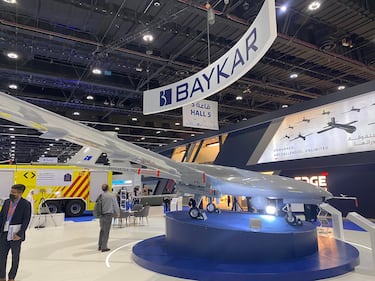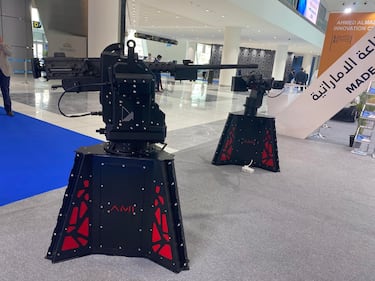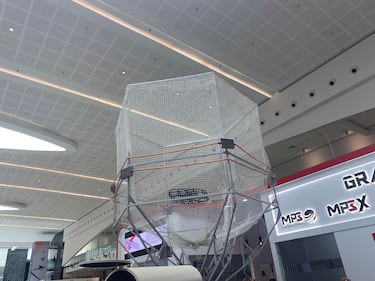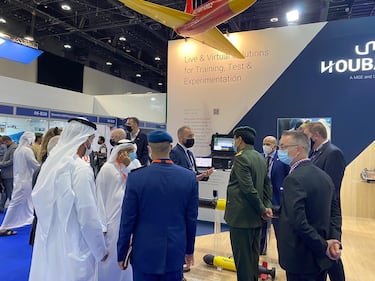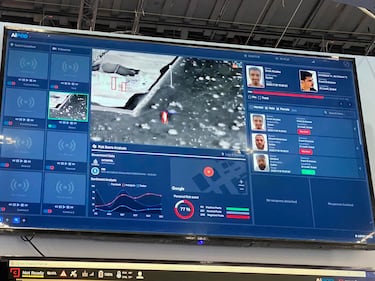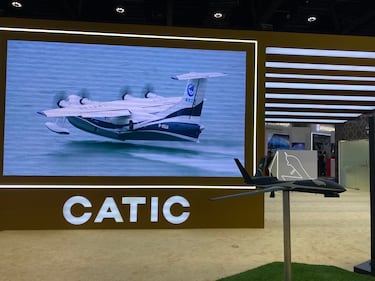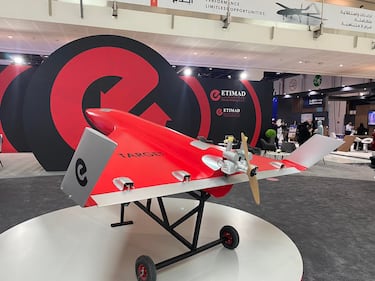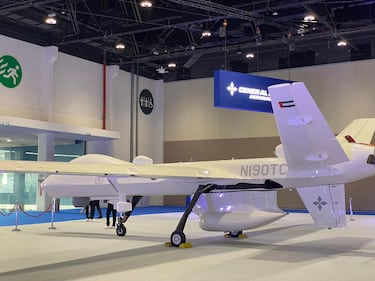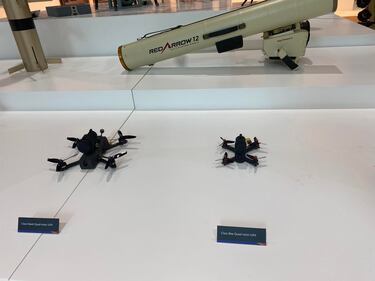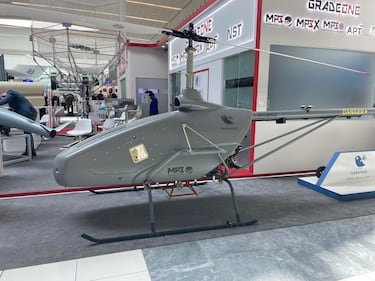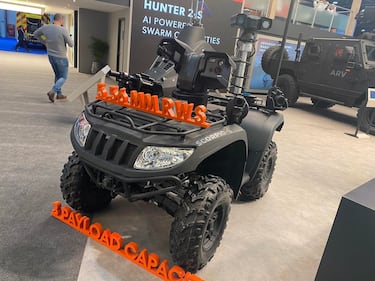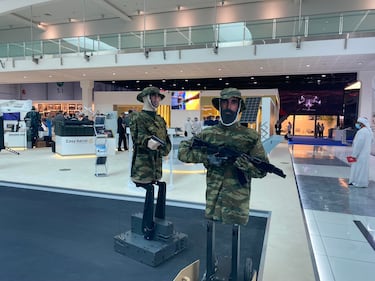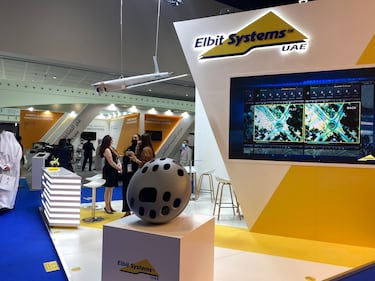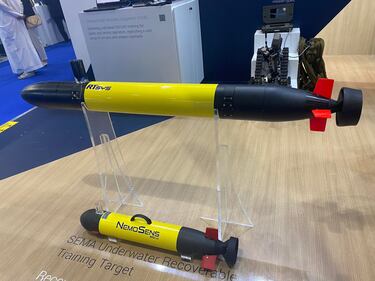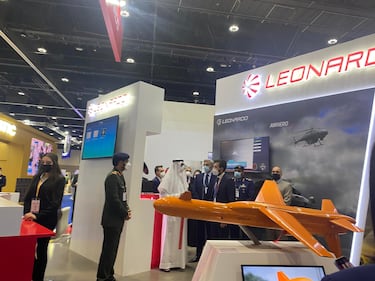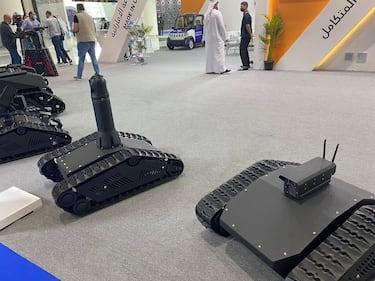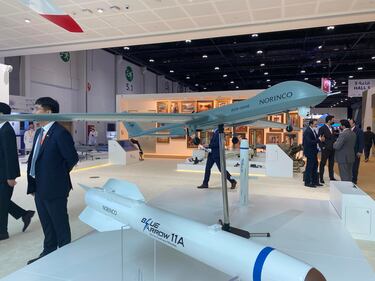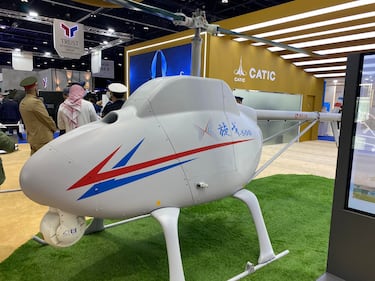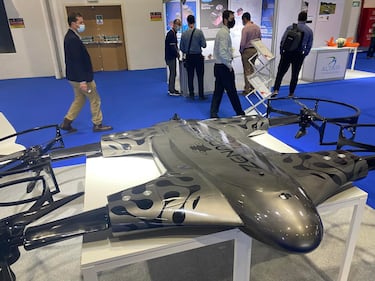Image 0 of 19
Correction: Cynax has already completed facial recognition work and have reportedly moved on to working on an additional risk analysis score technology.
ABU DHABI — Unmanned ground and aerial systems developed by Emirati companies dominated the tradeshow floor at the country’s unmanned systems expo UMEX, which took place Feb. 21-23, but foreign businesses also pitched their wares.
Defense conglomerate Edge Group unveiled the Scorpio-B unmanned ground vehicle, developed by its subsidiary Adasi. The UGV featured twin 40mm grenade launchers, pan-tilt-zoom cameras, intelligence, surveillance and reconnaissance sensors, and a 7IS remote controlled weapon station made of 80% 3D-printed material.
The weapon station weighs less than 40 kilograms (88 pounds) and can carry 50 rounds of munition, according to Saeed Al Mansoori, the CEO of Halcon, another Edge subsidiary. “Now we are in the demonstration phase until we sign a contract,” he told Defense News.
Beside the Edge booth, private company Ahmed Almazrouei Group showcased several of its UGVs, including a hybrid-powered robot that can be controlled from a distance of up to 10 kilometers (6.2 miles) and can be equipped with weapon systems. The business, which is also based in the United Arab Emirates, also brought surveillance and training ground vehicles as well as laser-guided autonomous shooting systems.
“The hybrid robot was tested with the UAE armed forces in harsh conditions in the country, during [high temperatures in] July ... and in the desert. It has entered production lines to produce 100 systems,” Ahmed Almazrouei, the company’s CEO, told Defense News.
Two combat drones were also on display: the MQ-9 SeaGuardian by American company General Atomics, and the Bayraktar TB-2 by Turkey’s Baykar Makina. The latter was a full-scale mockup and appeared alongside other drones produced by the company.
The full-scale SeaGuardian configuration of the MQ-9 featured maritime surface radar technology and an Emirati flag on its tail. The UAE in January 2021 signed off on a deal to purchase 18 MQ-9s from the United States, but it hasn’t been finalized amid disagreements between the two countries over F-35 fighter jets that are part of the package.
Unmanned systems meant for target practice were also at UMEX. UAE-based company Etimad unveiled four different types showcased with a truck-mounted drone launcher. Italian firm Leonardo exhibited the Mirach 40 target drone.
Houbara — a joint venture between the UAE’s Middle East General Enterprises and the U.K.’s QinetiQ — also showcased the target drone Banshee Jet 80 used by the Emirati Air Force. And French company RTSYS brought along its acoustic NemoSens target system.
Israeli companies also attended the show, with some — like Easy Aerial and Avnon — taking part through the Emirati organization International Golden Group. Others such as Elbit Systems, hosted separate stands. (While Easy Aerial is based in the United States, it has a regional office in Israel.)
China North Industries Group Corporation Limited — NORINCO for short — also had a presence at the IGG stand with several Chinese-made systems, including a sample of the BZK-005E UAV, rotary-wing and mini- drones, the Red Arrow and Blue Arrow missile systems, the Golden Eagle CR500A unmanned helicopter produced at the China-Emirates Science and Technology innovation laboratory.
The China National Aero-Technology Import and Export Corporation (better known as CATIC) had a large stand at the show, where it displayed the U8EA helicopter drone alongside other unmanned system mockups.
Russian companies Rostec and Kronshtadt did not attend the show, despite earlier reports that the Russian-made Orion and Orlan drones would be on display. However, Global Energy Transmission brought an autonomous in-flight charging system for drones.
The Russian system includes a waterproof receiving antenna, a high-power electronics module for power conversion, rapid-charging battery pack, and a data module for communication between the charging station and the onboard receiving system that allows drones to charge each other via their antennas, providing continuous flight thanks to in-flight recharging.
Saudi businesses were absent from UMEX; notably, the kingdom is hosting its own defense conference in early March, dubbed World Defense Show.
India’s Zen Technologies allowed UMEX attendees to choose a rifle or machine gun to simulate hitting targets in an environment similar to the Gulf region. The combat training specialist has an office in the UAE.
Australian company Marathon Target brought with it a small robot meant for training scenarios; the robot would mimic human response when shot by bending forward and continuing moving as if injured.
And Emirati firm Cynax unveiled the Kungsörn, a vertical-takeoff-and-landing surveillance drone that can launch from a truck. Data scientists with the company have completed a facial recognition feature and are reportedly working on risk analysis score technology by collecting social media data. They expect the technology will roll out in a few months and be used for security reasons.
Agnes Helou was a Middle East correspondent for Defense News. Her interests include missile defense, cybersecurity, the interoperability of weapons systems and strategic issues in the Middle East and Gulf region.
